|
Displaying items by tag: cityscapes
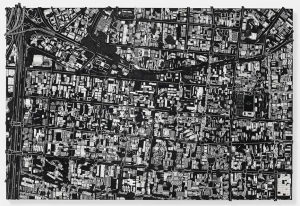
Damien Hirst has unveiled his new series of paintings in Brazil, following his universally panned exhibitions at the Wallace Collection, where he showed a group of Francis Bacon inspired skull paintings and his 2012 exhibition of "Parrot Pictures" at White Cube Bermondsey. For his latest painting exhibition, Hirst has created what he describes as "portraits of living cities," the "Black Scalpel Cityscapes" are made up of vast numbers of surgical instruments that combine to create bird’s-eye views of urbanized areas from around the world. With the series, Hirst investigates subjects pertaining to the sometimes-disquieting realities of modern life – surveillance, urbanisation, globalisation and the virtual nature of conflict – as well as elements relating to the universal human condition, such as our inability to arrest physical decay.
In the paintings, manmade features and natural elements such as buildings, rivers and roads are depicted in scalpels as well as razor blades, hooks, iron filings and safety-pins, all set against black backgrounds.
Modern Dialect: American Paintings from the John and Susan Horseman Collection, a striking new exhibition, opened at the Columbus Museum of Art June 6. The exhibition, on view through August 31, showcases American Modernist paintings from the 1920s to the beginning of World War II, a period marked by significant change and compounded by the onset of the Great Depression in the 1930s.
The more than sixty artists featured in Modern Dialect hail from all parts of the United States, and painted wherever they found inspiration. These artists adhere to a common interest, more than to a single style, in portraying their realities in a decidedly modern fashion. The exhibition reveals the scope of the American modernist aesthetic in the early 20th century, and the vision and integrity each artist brought to the representation of the American experience – from rural landscapes to modern industrial cities (and the people who inhabit them) to purely abstracted compositions.
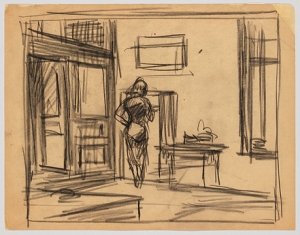
The Walker Art Center in Minneapolis, Minnesota is currently hosting the exhibition “Hopper Drawing: A Painter’s Process.” Organized by the Whitney Museum of American Art in New York, the show is the first major museum exhibition to focus on the drawings and creative process of the iconic American artist Edward Hopper. Known for his enigmatic renderings of rural and urban American life, Hopper’s paintings of seascapes, cityscapes, and their inhabitants are some of the most significant artworks of the 20th century.
“Hopper Drawing” offers viewers a rare glimpse into the creative process of an artist who produced one of the most lauded oeuvres in modern art. Hopper’s drawings illustrate his ever-changing relationships with his subjects, which include the street, the movie theater, the office, his bedroom, and the road. Drawn from the Whitney’s remarkable Hopper collection, which includes 2,500 drawings given to the museum by the artist’s widow, Josephine, “Hopper Drawing” includes drafts of some of the artist’s most recognized works alongside their painted counterparts. Works on view include “Early Sunday Morning,” “New York Movie,” “Nighthawks,” and “Office at Night,” from the Walker’s collection.
“Hopper Drawing: A Painter’s Process” will be on view at the Walker Art Center through June 20, 2014.
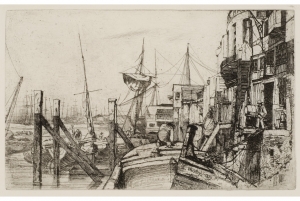
Dürer, Rembrandt & Whistler: Prints from the Collection of Dr. Dorrance T. Kelly is now on view at the Bruce Museum in Greenwich, CT. The exhibition is comprised of one of the finest local collections of Old Master prints, which was assembled by Dr. Dorrance T. Kelly. Kelly, who had primarily collected American 20th century prints and prints by John James Audubon (1785-1851) in the past, began collecting Old Master works in recent years.
Kelly’s collection includes rare etching, woodcuts and engravings by German printmaker Albrecht Dürer (1471-1528); nearly 30 works by Rembrandt (1606-1669); sheets by Canaletto (1697-1768); and several sheets by the Spanish artist Francisco de Goya (1746-1828). The collection is rounded out by a group of etched cityscapes and figure studies by James McNeil Whistler (1834-1903).
Dürer, Rembrandt & Whistler: Prints from the Collection of Dr. Dorrance T. Kelly will be on view at the Bruce Museum through August 18, 2013. A scholarly catalogue and educational programs complement it.
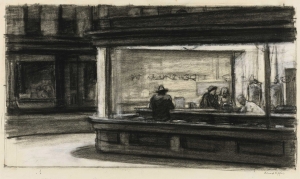
Hopper Drawing, which opens today, May 23, 2013 at the Whitney Museum of American Art in New York, is the first major museum exhibition to focus on the drawings and creative process of Edward Hopper (1882-1967). Known for his enigmatic renderings of rural and urban American life, Hopper’s paintings of seascapes, cityscapes, and their inhabitants are some of the most significant artworks of the 20th century.
The Whitney’s exhibition is not just a presentation of Hopper’s best-known works; it is a rare glimpse into the creative process that produced one of the most lauded oeuvres in modern art. Hopper’s drawings illustrate his ever-changing relationships with his subjects, which include the street, the movie theater, the office, the bedroom, and the road. Drawn from the Whitney’s remarkable Hopper collection, which includes 2,500 drawings given to the museum by the artist’s widow, Josephine, Hopper Drawing includes drafts of some of Hopper’s most recognized works alongside their oil painting counterparts. Works on view include Early Sunday Morning (1930), New York Movie (1939), Office at Night (1940), and Nighthawks (1942) together with their prepatory drawings and related works. The exhibition also includes pioneering archival research into the buildings and urban spaces that inspired Hopper’s work.
Drawing Hopper will be on view at the Whitney through October 6, 2013.
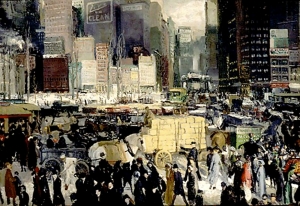
An expansive survey of works by the American realist artist, George Bellows, will open November 15 at the Metropolitan Museum of Art in New York City. The exhibition features 120 works including the paintings of boxing matches and gritty New York tenements that Bellows is best known for. The artist also painted cityscapes, seascapes, war scenes, portraits, and made illustrations and lithographs over the course of a varied career that was cut short when Bellows passed away at 42.
Born and raised in Columbus, Ohio, Bellows moved to New York City in 1904 to study with the influential artist and teacher, Robert Henri, and soon became the youngest member of the Ashcan School. Dedicated to chronicling the realities of day-to-day life, Bellows made a name as the boldest of the Ashcan artists. The Met acquired Bellows’ Up the Hudson (1808), the institution’s first Ashcan painting, in 1911.
Organized by the National Gallery of Art in Washington, D.C. in association with the Met and London’s Royal Academy of Art, the retrospective is the most comprehensive presentation of Bellows work in nearly fifty years. The exhibition will be on view through February 18, 2013.
|
|
|
|
|